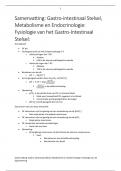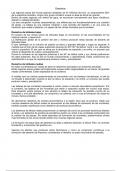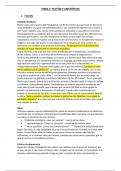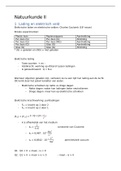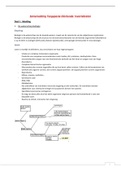Biochemistry and metabolic regulation
03/10/2019
Balance of anabolic and catabolic pathways in all cells
Alzheimer’s – accumulation of a specific protein in the brain due to lack of catabolism, major
neurological problems.
ATP formed from oxidation of food molecules
NADPH – major electron donor in reductive biosynthetic pathways (e.g. FA acetyl CoA
Carbon can form 4 bonds
Glucose is a main energy source because it’s soluble and doesn’t have double-bonds in it
Double-bonded products are insoluble
Lipids have double-bonds and are stored, but carbohydrates (glucose) can be used quickly
and easily and be transported easily as it doesn’t have double bonds.
Lipids need proteins to transport from one organelle to another, however glucose can travel
readily in the blood.
Intrinsic – enzyme activity -> allosteric -> feedback inhabitation -> enzyme isoforms (e.g.
LDH)
Extrinsic (hormonal)
Flux – overall flow rate
Rate determining step – metabolic enzymes not controlled individually , only crucial
enzymes
Energy metabolism controlled by hormones e.g. insulin
Intrinsic – Natural, essential
Allosteric – the alteration of the activity of an enzyme by means of a conformational change;
induced by another molecule
10/10/2019
Metabolism – sum of chemical reactions in living beings.
Digestion – From nutrients you get macromolecules, which are building blocks for other
molecules you need (e.g. amino acids to form proteins) and can provide energy for the body.
The macromolecules can also be useful by themselves too through function, storage (i.e.
glucose). BOTH macromolecules AND building blocks can provide functions like energy
metabolism.
Chemical oxidation – Burning with oxygen; the main principle for obtaining biological energy.
You always get carbon dioxide and H2O from energy production.
Lipids provide more energy than carbs, but organisms prefer carbs as it is utilized faster.
Penthose phosphate shunt – another phase that can happen during the glycolysis phase (5C
carbohydrates)
The 5-carbon production pathways can help make nucleotides that build up DNA.
Glycolysis – Glucose (6-carbon) is consumed, and broken in half to make 2 pyruvate
molecules (3-carbons each). Amino acids and glycerol can be produced from 3-carbon
metabolites. 2 ATPS and 2 NADHs (reduced co-enzymes) produced for EACH glucose.
Glycolysis energy investment – 1. Hexokinase invests an ATP to make glucose-6-phosphate
2. Phosphoglucomutase converts this o fructose-6-phosphate 3. Phosphofructokinase (rate
, limiting step of glycolysis, senses all energy levels, senses Kreb’s cycle activity, and is
allosterically regulated, meaning its regulated by an effector molecule) uses another ATP to
make fructose-1,6-diphosphate. 4. Aldolase splits this into 2 3-carbon pyruvate molecules. 5.
Triophosphateisomerase makes glyceraldehyde-3-phosphate (glycerol) AND
dihydroxyacetone phosphate. 6. Triphosphate dehydrogenase uses reduces NAD to NADH to
make 1,3-biphosphoglycerate (you just oxidise it and no energy is used). 7.
Phospherglycerokinase uses an ADP to make ATP and it gives you 3-phosphoglycerate
(makes amino acids serine, glycine, cysteine).
Because there are TWO ways it goes on step 5 (Triophosphateisomerase makes
glyceraldehyde-3-phosphate (glycerol) and that’s make into dihydroxyacetone phosphate),
so there are 2 NADH and 2 ATP created overall instead of 1.
8. Phosphoglucomutase reduces this to 2-phosphoglycerate 9. Enolase uses H2O to make
phosphoenolpyruvate 10. Pyruvate kinase uses ADP to make ATP for pyruvate.
Phosphofructokinase senses citrate levels in the Kreb’s cycle to make sure metabolic
activities are stable
Phosphoglycerokinase (PGK1) is important in substrate level phosphorylation. Is connected
with neurodegeneration, so is linked Parkinson’s disease cases.
Cancers can utilize glycolysis in certain ways, and PGK1 is studied to be beneficial in this
case.
Pyruvate dehydrogenase; pyruvate (if oxygen is present) can be added with NADH and CO2
to make acetyl-CoA for Kreb’s cycle and oxidative phosphorylation. Without oxygen,
pyruvate is added with NAD+ to make lactate. OR mixed with NAD+ and O2 to make ethanol.
Lactate dehydrogenase oxidises one NADH in pyruvate to make NAD+ and Lactate.
NAD+ plus CO2 = NADH
The Hif protein senses oxygen levels, so can change transcription of different enzymes in the
glycolysis cycles, and can decrease activity in hypoxic conditions
Gluconeogenesis is anabolic and occurs in the cytoplasm like glycolysis, but glycolysis is
catabolic instead. You can’t get the energy back in gluconeogenesis, its not reversible like
glycolysis.
Glucogenic amino acids – serine , glycine , cysteine
Gluconeogenesis can start from oxaloacetate, a Kreb’s cycle metabolite, and here lactate
may be converted into pyruvate.
NAD+ + H+ + 2 e <-> NADH (Niacin/B3 vitamins)
FAD + 2H+ + 2 e <-> FADH2 (Riboflavin/B2 vitamins)
Reduced forms of these ^ have higher potentials, and provide ATP via oxidative
phosphorylation
Krebs cycle - 1. Oxaloacetate (4C) + Acetyl CoA (2C) = citrate (6C) 2. 6C + CO2 NADH = 5C 3.
5C + CO2 NADH = 4C 4. 4C + GTP = 4C 5. 4C + FADH2 = 4C 6. 4C + NADH = 4C (cycle
continues)
KINASES ADDS OR TRANSFERS/DONATES PHOSPHATE GROUPS
ISOMERASES CATALYZE MOVEMENT OF A FUNCTIONAL GROUP FROM ONE POSITION TO
ANOTHER IN THE SAME MOLECULE (INCLUDES MUTASES).
ISOMERS – TWO/MORE COMPOUNDS WITH SAME COMPOUNDS BUT DIFFERENT
ARRANGEMENT
An aldehyde is when there’s a carbonyl group at the first carbon
A ketone is the same but not at the first carbon
, 17/10/2019
The small intestine gets 30% of its energy from amino acids. AAs can be catabolised from
proteins in people with high protein diets, diets low in proteins/carbs (especially during
starvation and disease), and when the small intestine catabolises proteins.
Amino group (Nitrogen) must be removed from the carbon skeleton before amino acids can
be utilized.
Amino acid carbon skeleton – COOH, hydrogen, R group (20 different kinds).
Glucose stored in liver, and muscles as glycogen.
Excess fat can be stored in adipose tissues (adipocytes), and can be utilized when glycogen
stores are depleted.
Step 1. Transamination – aminotransferase / transaminase swaps over two functional
groups. Swaps the amino group of the amino acid for the keto group of a keto acid.
Example: alanine (a transaminase, ALT) + a-ketoglutarate -> pyruvate + glutamate.
^^^ so the a-ketoglutarate can transaminate amino acids so the amino group from the 20
amino acids will all be converted to glutamic acid.
Alanine transaminase (ALT)
Pyridoxal phosphate (PLP) (Vitamin B6) forms the active site of alanine transaminase.
The amino group from alanine gets transferred to PLP, the vitamin B6 active site, by
pyridoxamine phosphate, and then it’s transferred by a-ketoglutaric acid to glutamate to
make glutamic acid.
(A-ketoglutaric acid is used in the TCA cycle to help generate energy), so amino acid
metabolism is also useful in glucose metabolism!
Alanine transaminase can be used in clinical diagnostics to check liver function; if you have
more than >40L within the blood it means the liver is damaged. The contents of the liver
cells will leak out and into the blood if necrosis or inflammation is present. So, ALT is a
biomarker of liver disease e.g. cirrhosis, alcoholic hepatitis, acute viral hepatitis, toxic or
ischemic injury like overdosing.
Step 2. Oxidative deamination – Glutamate is deaminated (an oxidation reduction reaction
where NAD+ is reduced to NADH) by the action of glutamate dehydrogenase (GDH), which is
an allosterically controlled enzyme regulated by ADP and ATP levels. This creates the toxic
chemical ‘ammonia’, which can be converted to urea.
ADP activates GDH but ATP inhibits GDH. If levels of ADP are high, GDP is sped up so
oxidative deamination works faster and it’s the opposite for ATP.
Most allosteric enzymes have multiple subunits, and are regulated via the binding of
allosteric regulator molecules such as inhibitors e.g. ATP, GTP OR activators e.g. ADP, GDP.
Inhibitors (TP), activators (DP)?
Ammonia – very toxic, 0.2mM or above. Not allowed in peripheral tissues due to the
possible inhibition of TCA enzymes and synthesis of neurotransmitters in the brain!!! Can be
temporarily converted to glutamine or asparagine, and then sent to the liver for conversion
to urea (ammonia -> converted to glutamine outside the liver -> converted to glutamate
once in the liver -> converted to urea and sent to kidneys for excretion).
Fish are able to excrete the ammonia through their gills instead of converting it, and it
dissolves in the water. This is why we have to test ammonia in fish tanks to see if the water
quality is good enough!
Urea cycle – occurs in the mitochondria, partly in the cytosol. NH4+ enters the urea cycle in
the mitochondria as carbonyl phosphate -> carbonyl group from carbonyl phosphate
combines with Ornithine, thus forming Citrulline -> Citrulline transferred out of
03/10/2019
Balance of anabolic and catabolic pathways in all cells
Alzheimer’s – accumulation of a specific protein in the brain due to lack of catabolism, major
neurological problems.
ATP formed from oxidation of food molecules
NADPH – major electron donor in reductive biosynthetic pathways (e.g. FA acetyl CoA
Carbon can form 4 bonds
Glucose is a main energy source because it’s soluble and doesn’t have double-bonds in it
Double-bonded products are insoluble
Lipids have double-bonds and are stored, but carbohydrates (glucose) can be used quickly
and easily and be transported easily as it doesn’t have double bonds.
Lipids need proteins to transport from one organelle to another, however glucose can travel
readily in the blood.
Intrinsic – enzyme activity -> allosteric -> feedback inhabitation -> enzyme isoforms (e.g.
LDH)
Extrinsic (hormonal)
Flux – overall flow rate
Rate determining step – metabolic enzymes not controlled individually , only crucial
enzymes
Energy metabolism controlled by hormones e.g. insulin
Intrinsic – Natural, essential
Allosteric – the alteration of the activity of an enzyme by means of a conformational change;
induced by another molecule
10/10/2019
Metabolism – sum of chemical reactions in living beings.
Digestion – From nutrients you get macromolecules, which are building blocks for other
molecules you need (e.g. amino acids to form proteins) and can provide energy for the body.
The macromolecules can also be useful by themselves too through function, storage (i.e.
glucose). BOTH macromolecules AND building blocks can provide functions like energy
metabolism.
Chemical oxidation – Burning with oxygen; the main principle for obtaining biological energy.
You always get carbon dioxide and H2O from energy production.
Lipids provide more energy than carbs, but organisms prefer carbs as it is utilized faster.
Penthose phosphate shunt – another phase that can happen during the glycolysis phase (5C
carbohydrates)
The 5-carbon production pathways can help make nucleotides that build up DNA.
Glycolysis – Glucose (6-carbon) is consumed, and broken in half to make 2 pyruvate
molecules (3-carbons each). Amino acids and glycerol can be produced from 3-carbon
metabolites. 2 ATPS and 2 NADHs (reduced co-enzymes) produced for EACH glucose.
Glycolysis energy investment – 1. Hexokinase invests an ATP to make glucose-6-phosphate
2. Phosphoglucomutase converts this o fructose-6-phosphate 3. Phosphofructokinase (rate
, limiting step of glycolysis, senses all energy levels, senses Kreb’s cycle activity, and is
allosterically regulated, meaning its regulated by an effector molecule) uses another ATP to
make fructose-1,6-diphosphate. 4. Aldolase splits this into 2 3-carbon pyruvate molecules. 5.
Triophosphateisomerase makes glyceraldehyde-3-phosphate (glycerol) AND
dihydroxyacetone phosphate. 6. Triphosphate dehydrogenase uses reduces NAD to NADH to
make 1,3-biphosphoglycerate (you just oxidise it and no energy is used). 7.
Phospherglycerokinase uses an ADP to make ATP and it gives you 3-phosphoglycerate
(makes amino acids serine, glycine, cysteine).
Because there are TWO ways it goes on step 5 (Triophosphateisomerase makes
glyceraldehyde-3-phosphate (glycerol) and that’s make into dihydroxyacetone phosphate),
so there are 2 NADH and 2 ATP created overall instead of 1.
8. Phosphoglucomutase reduces this to 2-phosphoglycerate 9. Enolase uses H2O to make
phosphoenolpyruvate 10. Pyruvate kinase uses ADP to make ATP for pyruvate.
Phosphofructokinase senses citrate levels in the Kreb’s cycle to make sure metabolic
activities are stable
Phosphoglycerokinase (PGK1) is important in substrate level phosphorylation. Is connected
with neurodegeneration, so is linked Parkinson’s disease cases.
Cancers can utilize glycolysis in certain ways, and PGK1 is studied to be beneficial in this
case.
Pyruvate dehydrogenase; pyruvate (if oxygen is present) can be added with NADH and CO2
to make acetyl-CoA for Kreb’s cycle and oxidative phosphorylation. Without oxygen,
pyruvate is added with NAD+ to make lactate. OR mixed with NAD+ and O2 to make ethanol.
Lactate dehydrogenase oxidises one NADH in pyruvate to make NAD+ and Lactate.
NAD+ plus CO2 = NADH
The Hif protein senses oxygen levels, so can change transcription of different enzymes in the
glycolysis cycles, and can decrease activity in hypoxic conditions
Gluconeogenesis is anabolic and occurs in the cytoplasm like glycolysis, but glycolysis is
catabolic instead. You can’t get the energy back in gluconeogenesis, its not reversible like
glycolysis.
Glucogenic amino acids – serine , glycine , cysteine
Gluconeogenesis can start from oxaloacetate, a Kreb’s cycle metabolite, and here lactate
may be converted into pyruvate.
NAD+ + H+ + 2 e <-> NADH (Niacin/B3 vitamins)
FAD + 2H+ + 2 e <-> FADH2 (Riboflavin/B2 vitamins)
Reduced forms of these ^ have higher potentials, and provide ATP via oxidative
phosphorylation
Krebs cycle - 1. Oxaloacetate (4C) + Acetyl CoA (2C) = citrate (6C) 2. 6C + CO2 NADH = 5C 3.
5C + CO2 NADH = 4C 4. 4C + GTP = 4C 5. 4C + FADH2 = 4C 6. 4C + NADH = 4C (cycle
continues)
KINASES ADDS OR TRANSFERS/DONATES PHOSPHATE GROUPS
ISOMERASES CATALYZE MOVEMENT OF A FUNCTIONAL GROUP FROM ONE POSITION TO
ANOTHER IN THE SAME MOLECULE (INCLUDES MUTASES).
ISOMERS – TWO/MORE COMPOUNDS WITH SAME COMPOUNDS BUT DIFFERENT
ARRANGEMENT
An aldehyde is when there’s a carbonyl group at the first carbon
A ketone is the same but not at the first carbon
, 17/10/2019
The small intestine gets 30% of its energy from amino acids. AAs can be catabolised from
proteins in people with high protein diets, diets low in proteins/carbs (especially during
starvation and disease), and when the small intestine catabolises proteins.
Amino group (Nitrogen) must be removed from the carbon skeleton before amino acids can
be utilized.
Amino acid carbon skeleton – COOH, hydrogen, R group (20 different kinds).
Glucose stored in liver, and muscles as glycogen.
Excess fat can be stored in adipose tissues (adipocytes), and can be utilized when glycogen
stores are depleted.
Step 1. Transamination – aminotransferase / transaminase swaps over two functional
groups. Swaps the amino group of the amino acid for the keto group of a keto acid.
Example: alanine (a transaminase, ALT) + a-ketoglutarate -> pyruvate + glutamate.
^^^ so the a-ketoglutarate can transaminate amino acids so the amino group from the 20
amino acids will all be converted to glutamic acid.
Alanine transaminase (ALT)
Pyridoxal phosphate (PLP) (Vitamin B6) forms the active site of alanine transaminase.
The amino group from alanine gets transferred to PLP, the vitamin B6 active site, by
pyridoxamine phosphate, and then it’s transferred by a-ketoglutaric acid to glutamate to
make glutamic acid.
(A-ketoglutaric acid is used in the TCA cycle to help generate energy), so amino acid
metabolism is also useful in glucose metabolism!
Alanine transaminase can be used in clinical diagnostics to check liver function; if you have
more than >40L within the blood it means the liver is damaged. The contents of the liver
cells will leak out and into the blood if necrosis or inflammation is present. So, ALT is a
biomarker of liver disease e.g. cirrhosis, alcoholic hepatitis, acute viral hepatitis, toxic or
ischemic injury like overdosing.
Step 2. Oxidative deamination – Glutamate is deaminated (an oxidation reduction reaction
where NAD+ is reduced to NADH) by the action of glutamate dehydrogenase (GDH), which is
an allosterically controlled enzyme regulated by ADP and ATP levels. This creates the toxic
chemical ‘ammonia’, which can be converted to urea.
ADP activates GDH but ATP inhibits GDH. If levels of ADP are high, GDP is sped up so
oxidative deamination works faster and it’s the opposite for ATP.
Most allosteric enzymes have multiple subunits, and are regulated via the binding of
allosteric regulator molecules such as inhibitors e.g. ATP, GTP OR activators e.g. ADP, GDP.
Inhibitors (TP), activators (DP)?
Ammonia – very toxic, 0.2mM or above. Not allowed in peripheral tissues due to the
possible inhibition of TCA enzymes and synthesis of neurotransmitters in the brain!!! Can be
temporarily converted to glutamine or asparagine, and then sent to the liver for conversion
to urea (ammonia -> converted to glutamine outside the liver -> converted to glutamate
once in the liver -> converted to urea and sent to kidneys for excretion).
Fish are able to excrete the ammonia through their gills instead of converting it, and it
dissolves in the water. This is why we have to test ammonia in fish tanks to see if the water
quality is good enough!
Urea cycle – occurs in the mitochondria, partly in the cytosol. NH4+ enters the urea cycle in
the mitochondria as carbonyl phosphate -> carbonyl group from carbonyl phosphate
combines with Ornithine, thus forming Citrulline -> Citrulline transferred out of


